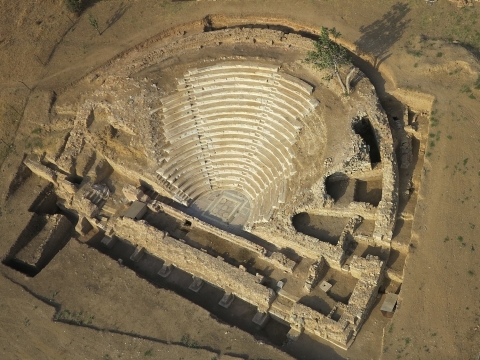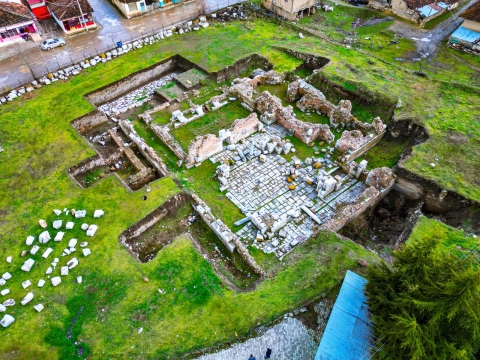Parion’s Submerged Secrets: Ottoman Maritime Traces Unveiled by OMU
Excavations continue in the 2,700-year-old port city of Parion, located in the village of Kemer in the Biga district of Çanakkale.
This year’s excavations are being led by a team of 36 experts, including 18 international participants, under the supervision of Prof. Dr. Vedat Keleş, Dean of the Faculty of Humanities and Social Sciences and Chair of the Department of Archaeology at Ondokuz Mayıs University (OMU). Underwater studies in the ancient city of Parion have revealed numerous Ottoman ceramics as well as possible remains of an Ottoman shipyard.
Prof. Dr. Vedat Keleş, head of the excavation team, stated that many Ottoman-era ceramics were unearthed at the ancient harbor, saying, “Although we have been excavating this ancient city for 20 years, we had never previously encountered any artifacts from the Ottoman period. Now, we have discovered a considerable number of Ottoman ceramics underwater.”
“We discovered a large quantity of Ottoman ceramics underwater”
Emphasizing that Parion was one of the most significant port cities of the ancient Northern Troad region, Prof. Dr. Vedat Keleş shared details of the ongoing excavations:
“The 2025 excavation works at the ancient city of Parion are continuing with permission and financial support from the General Directorate of Cultural Assets and Museums of the Ministry of Culture and Tourism. Additional support is being provided by the Governorship of Çanakkale, our official sponsor İÇDAŞ A.Ş., the Rectorate of Ondokuz Mayıs University, and through workforce assistance from the Biga District Governorate and Biga Municipality.
Currently, we are conducting our work with a team of 36 people. Eighteen members of the team are international colleagues from Moscow High School of Economics and Paris Montaigne University, and the remaining 18 include local workers and Turkish archaeologists.
This year, one of our main focuses will be underwater research, as we encountered surprising findings during a short underwater investigation conducted last year in the southern harbor of Parion by Assoc. Prof. Dr. Ahmet Bilir and his team from Düzce University.”
Prof. Dr. Keleş continued:
“Although we’ve been excavating this site for two decades, until last year, we hadn’t encountered a single Ottoman-period artifact. During our short underwater investigations last year, we discovered a significant number of Ottoman ceramics. This led us to conduct a literature review, through which we discovered that the Kemer Pier served as a key timber supply point for the Ottoman Navy from 1574 until the 19th century—a period of over 300 uninterrupted years. It was also one of the most critical shipment points for firewood to Istanbul during times of shortage.
We consider this discovery to be as exciting for our national history as it is for understanding the ancient era of the city.”
“These studies may also lead us to ancient and Ottoman-era shipwrecks”
Highlighting that the Bodrum Cape in the southern harbor is also known as “Tersane Burnu” (Shipyard Cape), Prof. Dr. Keleş added:
“We now realize that this is no coincidence. This year, we intend to accelerate our underwater investigations. The area lies along the Dardanelles Strait, which has historically been one of the world’s most important maritime routes.
The ceramics discovered during our underwater work strongly corroborate the findings from our literature research on the Ottoman period. The studies we will conduct on these ceramics, along with further underwater investigations around the ancient harbor, may potentially lead us to uncover both ancient and Ottoman-era shipwrecks. This shows that our work may contribute not only to knowledge of the region’s ancient history but also to Ottoman naval heritage.
The findings from our underwater work, coupled with our literature research and the region’s ongoing activities, demonstrate a historical continuity in maritime practices. Interestingly, our official sponsor İÇDAŞ A.Ş. is today one of the most prominent shipbuilding and ship repair facilities in the region and the country. This indicates a remarkable continuity in the region’s maritime industry from past to present. We’ve also discovered that the Kemer Shipyard and pier were once used for constructing ships for the Ottoman Navy, including vessels for the Egyptian fleet.
These findings suggest that a substantial Ottoman shipyard and related facilities may exist underwater next to the ancient harbor.”
Prof. Dr. Keleş emphasized that the initial traces were discovered last year and concluded:
“We plan to further investigate these findings this season and in the years to come. We will seek support from local administrators and the Ministry to ensure these studies are carried out effectively. If our data increases and shipwrecks are discovered, the establishment of an underwater research institute affiliated with Çanakkale Onsekiz Mart University may even be considered in the future.”



















